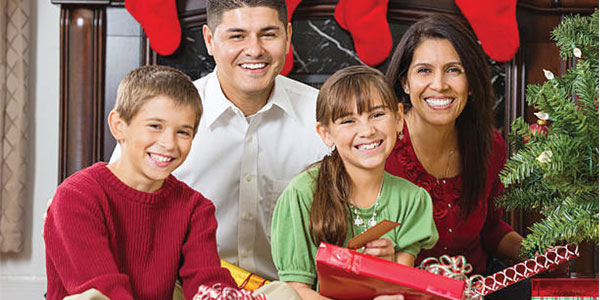
By Tere Siqueira
For many U.S. Latinos, Christmas is a time to explore the roots of their faith and culture.
Some of the key characteristics of Hispanic Christmas celebrations include the following:*Date: Hispanic families typically celebrate on Christmas Eve (Nochebuena in Spanish), rather than Christmas Day. Usually, they gather on Dec. 24 to enjoy a big dinner and hand out presents. The big party begins at night and often ends after midnight. Dec. 25 is a quiet day to recuperate from the big celebration, when families gather again and reheat their leftovers.*Menu: Christmas offers another opportunity for Hispanics to display their culinary skills by bringing many dishes to the table. Some of the most common Christmas dishes include stuffed turkey, tamales, roasted adobada pork leg, salted cod, apple salad, Christmas fruit punch, warm champurrado, eggnog rompope and bunuelos (buñuelos in Spanish).
*Pastorelas: Pastorelas are plays that recreate Christ’s birth. The characters in the plays often include Mary, Joseph, angels, shepherds, the three kings and an important humorous Satan role. The main message of this tradition is that good prevails over evil.
*Las Posadas: The Christmastime tradition commemorates Mary and Joseph’s journey in seeking shelter to give birth to Jesus Christ. Starting on Dec. 16, the celebration runs for nine evenings. During the Posadas, friends and family members gather in a house to be part of activities that include beating a pinata (piñata in Spanish), displaying candles to symbolize the providing of guidance to the travelers seeking shelter, and enjoying traditional food and drinks.
*The end of the holidays: Hispanic celebrations generally continue through Feb. 2. First, people celebrate Three Kings Day (a.k.a., the Epiphany) on Jan. 6. On this day, children receive presents and the family gathers to eat a pastry decorated with candied fruit known as the rosca. The rosca is baked with a figurine of the baby Jesus inside. Whoever finds the figurine in their piece is responsible for bringing food to the Feb. 2 Candlemas celebration.
*Candlemas: Candlemas is the last day of the Latino Christmas season. Families bring the infant Jesus from their nativity scenes to church. Later, they eat tamales and atole.
____________________________________________________________________________________________
Las tradiciones dan a las celebraciones navideñas hispanas un sabor único
Para muchos latinos estadounidenses, la Navidad es un momento para explorar las raíces de su fe y cultura.
Algunas de las características clave de las celebraciones hispanas de Navidad incluyen las siguientes:
* Fecha: Las familias hispanas suelen celebrar en Nochebuena, en lugar de Navidad. Por lo general, se reúnen el 24 de diciembre para disfrutar de una gran cena y repartir regalos. La gran fiesta comienza en la noche y suele terminar después de la medianoche. El 25 de diciembre es un día tranquilo para recuperarse de la gran celebración, las familias se reúnen de nuevo y recalientan las sobras.
* Menú: La Navidad ofrece otra oportunidad para que los hispanos muestren sus habilidades culinarias al traer muchos platos a la mesa. Algunos de los platos de Navidad más comunes incluyen pavo relleno, tamales, pechuga de cerdo adobada asada, bacalao salado, ensalada de manzana, ponche de frutas navideño, champurrado caliente, rompope de yema y buñuelos.
* Pastorelas: Las Pastorelas son obras que recrean el nacimiento de Cristo. Los personajes en las obras a menudo incluyen a María, José, los Ángeles, los Pastores, los tres Reyes y un importante papel humorístico de Satanás. El mensaje principal de esta tradición es que el bien prevalece sobre el mal.
* Las Posadas: La tradición navideña conmemora el viaje de María y José en la búsqueda de refugio para dar a luz a Jesucristo. A partir del 16 de diciembre, la celebración durará nueve noches. Durante las Posadas, amigos y familiares se reúnen en una casa para participar en actividades que incluyen golpear una piñata, utilizan velas para simbolizar la orientación de los viajeros que buscan refugio y disfrutar de comidas y bebidas tradicionales.
* El final de las celebraciones: Las festividades hispanas generalmente continúan hasta el 2 de febrero. Primero, la gente celebra el día de los Reyes Magos (también conocido como la Epifanía) el 6 de enero. En este día, los niños reciben regalos y la familia se reúne para comer un panqué decorado con fruta confitada conocida como la rosca. La rosca se hornea con una figurita del niño Jesús adentro. Quienquiera que encuentre la figura en su pieza es responsable de llevar comida a la celebración de la Candelaria del 2 de febrero.
* Candelaria: Candelaria es el último día de la temporada navideña latina. Las familias traen al niño Jesús de sus escenas de nacimiento a la iglesia. Posteriormente, comen tamales y atole.









